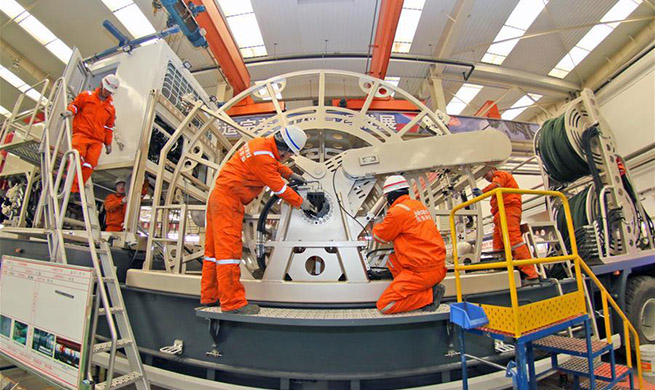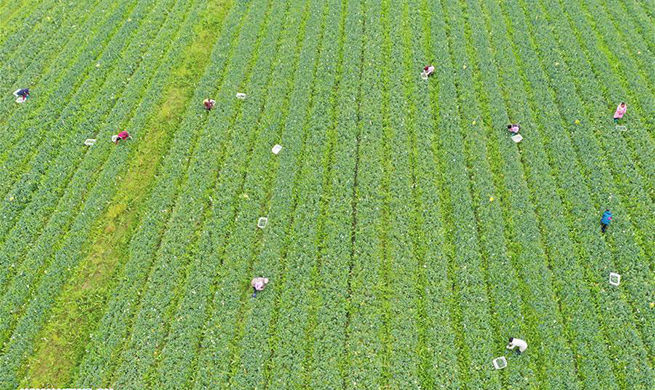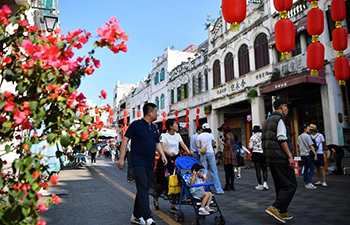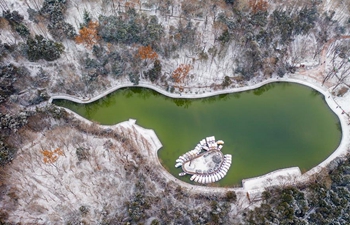URUMQI, Feb. 12 (Xinhua) -- Stunning desert, sweet grapes and scorching heat make Turpan an ideal place for curious travelers and even automakers conducting heat exposure experiments.
However, botanist Pan Borong came to the city in northwest China's Xinjiang Uygur Autonomous Region for a special purpose -- opening a plant "bank" in the desert.
"If a plant can survive in extreme conditions such as temperature as high as 50 degrees Celsius, frequent sandstorms and drought, it can survive anywhere," said Pan, a retired researcher from the Xinjiang Institute of Ecology and Geography, Chinese Academy of Sciences.
Pan and his colleagues came to Turpan in 1972 and were assigned to help five local farms that were frequently plagued by gales and sandstorms to fight desertification.
"It was an arduous start," he recalled.
To buy rice, edible oil and vegetables, researchers had to take a 20-km bike trip to the nearest county, taking turns cooking.
They lived in shabby houses with windows made of plastic and relied on kerosene lamps at night. In the spring, heavy winds would tear apart the windows, leaving dust and sand everywhere.
Despite the difficulties, researchers started introducing sand-fixation plants to Turpan. A dozen of them such as rose willows and desert poplar proved adaptable to the local climate and soil conditions.
Based on this vegetation, they decided to set up Xinjiang's first botanical garden in 1975 and named it the Turpan Eremophytes Botanic Garden.
"The arid desert area accounts for a quarter of China's land. We want to collect and introduce various drought-resistant plants in the botanical garden for further research," Pan said. "It's just like a 'bank of plants'."
To collect the plants, Pan and his colleagues ventured into distant basins and mountains. Their footprints were even left in foreign areas such as Russia, central Asian countries, Libya and Syria.
It is very likely to encounter dangers in the vast wilderness.
Sometimes to find a plant, they had to take bus, ride bikes and hop on a donkey cart to reach remote destinations. In some untraversed areas, Pan's only method to reach plants to deposit in his "bank" was to walk.
In October of 1980, Pan broke his cervical vertebra in an accident during an expedition to Kazakh Autonomous Prefecture of Yili. He stayed in the hospital for more than nine months and underwent two operations.
His decades-long endeavor has paid off. The botanic garden covers an area as large as 210 standard football fields. It is home to more than 700 species of desert plants, including nearly 100 rare and endangered species of desert plants.
China has been conducting afforestation and forest conservation programs in Xinjiang for decades to fight desertification and over-grazing in the region.
"The botanical garden is significant to the sustainable development of China's desert areas," said botanist Hong Deyuan, an academician of the Chinese Academy of Sciences.
Though Pan has retired, he has not stopped researching.
The plants from his "bank" have helped restore and reconstruct the ecosystem in the middle and lower reaches of the Tarim River, China's longest inland river, and in several polluted areas surrounding oilfields.
He and his colleagues have been bringing the desert plants and research results to broader domains. Twenty tonnes of sand-fixation plant seeds and more than 3 million saplings have been sent to other areas in and outside Xinjiang in northwest China.
"We can deposit abundant desert plants in the 'bank' and take out the 'savings' when needed," Pan said.

















